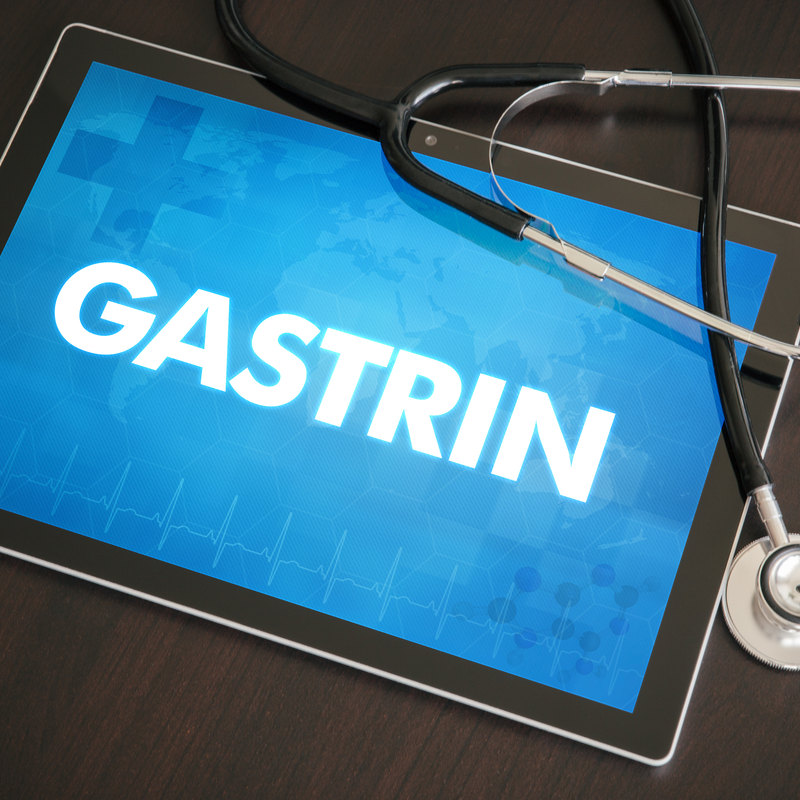
What is Zollinger-Ellison syndrome?
Zollinger-Ellison syndrome develops due to an over-secretion of gastrin . Gastrin is a peptide hormone of the gastrointestinal tract that stimulates the magn to produce more hydrochloric acid. In Zollinger-Ellison syndrome, a constellation of symptoms occurs which is characterised by severe gastroduodenal ulcer disease, hypergastrinemia (increased concentration of gastrin in the blood serum) and the appearance of a tumour, a so-called gastrinoma, in the pancreas or duodenum . The disease was named after its discoverers, the American surgeons Robert Milton Zollinger and Edwin Homer Ellison. It is extremely rare, but can theoretically develop at any age. However, in most cases, Zollinger-Ellison syndrome occurs between 30 and 60 years of age.
What causes Zollinger-Ellison syndrome to develop?
Zollinger-Ellison syndrome develops in 75 percent of all cases due to rare tumours in the pancreas and in 25 percent of all cases due to tumours in the upper part of the small intestine. The tumours that trigger Zollinger-Ellison syndrome produce the hormone gastrin and are therefore also called gastrinoma. A gastrinoma is a neuroendocrine tumour (NET) and can occur as a single or multiple tumour and secretes large amounts of gastrin continuously. Gastrinomas, which are neuroendocrine tumours and develop from the cells, hormones and messengers, are malignant in about 60 percent of all cases and can settle in the liver and/or lymph nodes.
What can cause a gastrinoma?
A Gastrinoma often develops spontaneously, but can sometimes occur in combination with multiple endocrine neoplasia type 1 (MEN 1) . In this case, tumours form in several organs at the same time. These tumours occur with above-average frequency in the hormone gland in the brain (pituitary gland), the parathyroid glands, the adrenal glands and in the pancreas. The disease is hereditary and is caused by a mutation in the DNA.
What is gastrin?
Gastrin is a tissue hormone that has a strong effect on the digestive tract. Gastrin is usually thought to
- increase the production of gastric acid,
- stimulate the production of pepsinogen and histamine; both substances are important for the digestion of food,
- stimulate the stomach muscles,
- trigger substances like insulin to be released from the pancreas,
What are the symptoms of Zollinger-Ellison syndrome?
A gastrinoma produces gastrin, which causes an overproduction of stomach acid. This increase in acidity can contribute to the development of stomach ulcers (ventriculi ulcers) and duodenal ulcers (duodenal ulcers). Typical symptoms that may occur due to Zollinger-Ellison syndrome are:
- Abdominal pain, especially in the ulcer of the stomach or in the duodenum, sometimes also in the jejunum,
- gastro-oesophageal reflux, which can lead to inflammation in the oesophagus,
- bloody vomiting (haematemesis), which can occur occasionally,
- diarrhoea, which can occur in about half of all cases,
- occasional fatty stools, which are caused by a disturbance in the digestion of fats,
- in isolated cases, hypokalaemic metabolic alkalosis,
- very rare hyperparathyroidism
- Heartburn,
- Ulcers in the stomach and/or duodenum,
The specific symptoms experienced by patients depend on which organs are affected by the tumours.
How is Zollinger-Ellison syndrome diagnosed?
In Zollinger-Ellison syndrome is usually diagnosed quite late because the disease is rare and the symptoms also allow for a variety of other digestive disorders. Symptoms such as heartburn or stomach ulcers are therefore initially dismissed with an unhealthy diet and advise the patient to change their diet . Only when treatment with the usual medicines does not bring relief or the ulcers recur does the suspicion of Zollinger-Ellison syndrome arise.
A Zollinger-Ellison syndrome can then be diagnosed mainly by the increased gastrin level (hypergastrinemia). If a level above 1?000 ng/l is detected, this is an almost certain sign of Zollinger-Ellison syndrome. In addition to an elevated gastrin level, in Zollinger-Ellison syndrome there is also an almost 100% increase in the gastrin level, if this has previously been provoked by secretin (secretin test). In addition, Zollinger-Ellison syndrome can be diagnosed by the usual imaging methods . These can include an octreotide test. These may include an octreotide scintigraphy, positron emission tomography, magnetic resonance imaging (MRI), computed tomography (CT) or endoluminal ultrasound .
Following the diagnosis, it is important to determine whether a simple gastrinoma is present or whether MEN1 is causing the symptoms. To clarify this question, the kidneys, the pituitary gland (gland at the base of the brain), and also the thyroid gland must be examined for tumours.
How is Zollinger-Ellison syndrome treated?
For the treatment of Zollinger-Ellison syndrome, proton pump inhibitors can be used, which reduce acid secretion. However, if possible, the tumour should be surgically removed. However, surgery is only promising if the tumour has not yet spread metastases. For the treatment of malignant, metastatic tumours, palliative approaches can be used. In this case the focus is on extending the patient's life as long as possible. Chemotherapy is not very effective in treating Zollinger-Ellison syndrome.
What is the prognosis for Zollinger-Ellison syndrome?
Zollinger-Ellison syndrome can only be completely cured if the gastrinoma has not yet spread to metastases. In the case of metastasis, the patient's life can be prolonged for several decades by palliative approaches.
